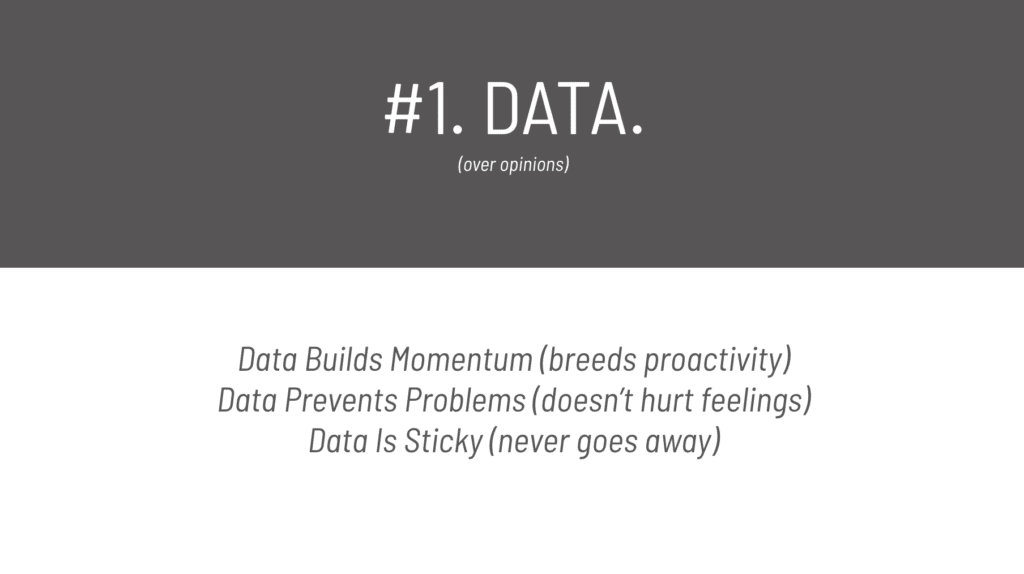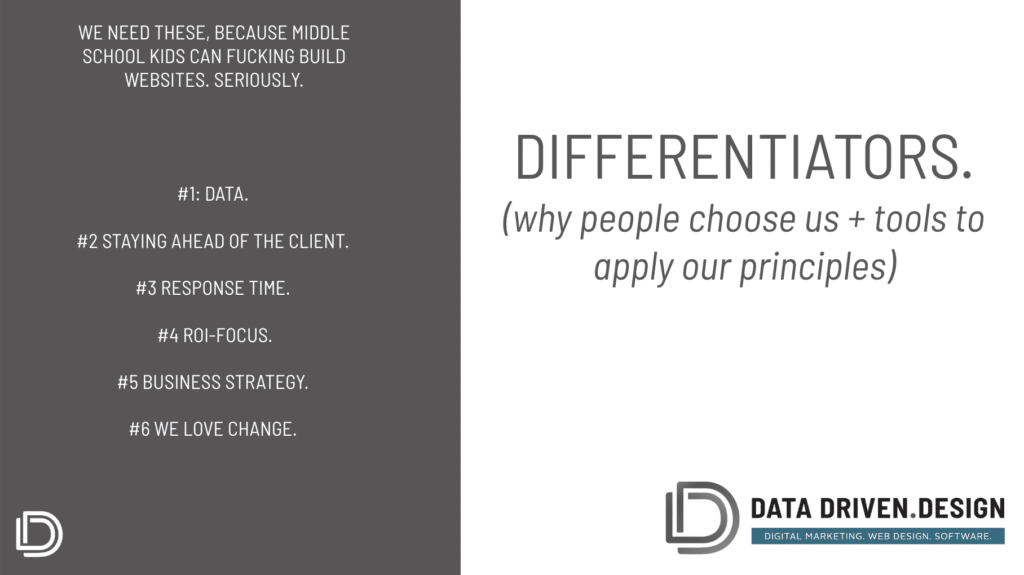Differentiator #1: Data (Over Opinions)
READ
In 2011, when I was hired by an agency in Nashville to perform Digital Strategy, SEO and Web Design and Development services for clients, it became super clear to me on my first projects, that everything was always at risk.
Let me explain.
The owner of a small business runs the ship. He or she can change her mind at any given time, and if they're not convinced, it's over.
Additionally, design by committee is equally dangerous.
A super-committed VP of Marketing at a mid-size level company or emerging enterprise brand also needs buy-in from their team, and other teams, such as IT, Operations, Sales and ultimately, the office of the CEO.
Even if they say they don't at the beginning of a project, by the end of it, they most certainly do.
And not that they're lying to you, but that things change when people see designs. Period.
That's why, you can choose to have a middle school kid or a freelancer design and develop your website.
You can even choose to overpay a fancy larger agency to cover their beer on tap at their fancy office, or you can go with the professionals that use data.

1. Data Prevents Problems.
I’m obsessed with productivity. Subjectivity kills momentum, which slows productivity. But subjectivity in design is very real. But it doesn’t have to be. Let me explain.
Early on in my career designing websites for clients, I realized just how subjective “web design” is. Web Design, unlike all other kinds of design, is so subjective, that all elements get spread out onto the table and picked apart worse than Heidi Klum, Nina Garcia and Michael Kors pick apart fashion designers on Project Runway. Nearly 100% of the time, Klum, Garcia and Kors disagree, and just like the garments and accessories they argue over, CEOs, VPs of IT and Marketing Directors would argue ad nauseam in front of my team and I for countless hours, debating button color, image selection, image placement, navigation titles, navigation placement, footer size, amount of interior pages – and that was before we even got to or finished the web copy (what to say on the website).
Before you know it, what should have been a 3-week, $2,500 project, had grown to a 12-month, $40k ordeal.
I found myself transitioning from the web design and development business quickly to the “managing scope creep and agreed upon signed change order” business. It sucked, honestly.
But then, after a few failed projects early on, I realized that the only thing going wrong was that there was no determining factor of what to do.
Unlike the Project Runway judges, our client’s design committee could NOT come to conclusions, and we were unable to convince them what to do, because all we had were our opinions.
UNTIL, one day I realized that the same tool that I had been using for several years to grow web traffic for clients, Google Analytics, could also be used to make data driven design decisions.
Klum, Garcia and Kors HAD to be subjective. All they had were their opinions. But we didn’t. We had DATA!
We had data that showed us which pages on their current website performed the best and which didn’t (Bounce Rate).
We had data that showed us which pages kept people moving through the site with the same flow our clients want them to.
We even dug deeper into our toolkit and added more analytics tools like heatmapping, A/B testing and competitive analytics, that showed us where users click and where they don’t click, where they scroll to and what they ignore, and perhaps most importantly, what works for their competition, and what doesn’t.
We developed the process of using this data at the beginning of projects to be proactive. To lay the groundwork for what we knew was coming.
We used this data proactively to tell the story of how we knew we needed to design their website and WHY.
I was sick of wasting my time wasting our clients’ money. Data keeps projects moving productively.
So, because with Web Design, unlike other kinds of design, you can use technology to put code snippets on to collect data, design not only doesn’t have to be subjective and opinion-based, but it SHOULDN’T be.
Look, we’re all going to have opinions, and we’re all going to disagree, sometimes even on how to interpret the data, but most things with data are always clear.
When you have this kind of layout vs. that kind of layout, or when you have this button color or this image vs that button color or image, your site performs “X amount better.”
Because websites are not printed media and can be changed at any point in time to reflect what the user sees based on any number of factors related to who the user is, where they’ve entered a website from, or what they’ve done on a particular website in the past, momentum need never be lost on a web project. Unlike physical design or printed design or art, Web Design – and the design of digital marketing strategies and tactical efforts to drive revenue – can be constantly tweaked and optimized based on data. It never stops, so you shouldn’t either.
In other words, Web Design projects never need to stop or be delayed. The answer is always, always, always to publish, analyze, tweak, and repeat.
While most Web Design and Digital Marketing companies launch and go away, we are iterative, constantly improving based on data. That, is our differentiator, and as you all know, any successful business needs a differentiator.
3. Data Doesn’t Hurt Feelings. Opinions do. While “designers and creatives” have been labeled as “emotional” based on how people react to their creations – feedback based on data doesn’t hurt feelings.
Perhaps more importantly, in the client services business, “non-creatives,” or decision-making people in executive level jobs that are judging the creation based on their opinions, often get their feelings hurt when their feedback isn’t implemented into a Web Design or Digital Marketing Strategy Design, data again doesn’t hurt feelings. This is ego-driven, and also kills productivity, but it’s true – they get their feelings hurt.
People say business isn’t personal, but let’s be honest, it is. It’s all personal. Business is relationships, and relationships are personal. Feelings and emotions are real. If our team doesn’t do what the VP of IT says to do on a Web Design project, even though it conflicts with what everyone else is aligned on, if we present a data driven rationale and explain that the reason we’re all aligned is because the data shows eCommerce conversion rates increase 23% with a particular image, layout, color or web copy, it changes the game and takes feelings out of it.
Now, Susie from IT isn’t getting called out, she’s getting educated and included.
We need to acknowledge that, and use data to prevent hurt feelings, because hurt feelings kill productivity.
In closing, we haven’t really chosen to be defined by data, we’ve just chosen to be productive over being unproductive, and data is our tool to get there, on all of our engagements.
Note: I fully understand that even reading and interpreting data can be subjective, and that context is critical to this process. You need Data + Context in order to have the Path Forward.
But we have more experience reading web data than any team out there, and have tested our theories constantly to ensure we’re driving the best results for our clients. We’ve gone from simply looking at data, to knowing what data will give us the most truth based on context, to making decisions based on that.
Data Driven Design includes the analytical piece that drives results and productivity, but wouldn’t be fully complete without the Design piece.
Because of Data, we are the Project Runway judge that can pick the collection that will convert the masses, then design it over and over again for any type of business.

After those first few projects went awry in 2011, I've used data every single day to base decisions on. Now, our team at Data Driven Design does the same, and we do it better than anyone.
Because of this, we remove opinions, we look at facts, and we iterate to get you the best results.
Data is our number one differentiator (reason you should pick us over the competition), and I'm fine being transparent with this, because it's not easy to do. If others want to try and replicate it, be my guest!
We love it, we find it fun, and we know it works, so for those reasons, we will always be the best team to analyze your data and help you extract insights and action items to improve your business.
Click here to view all of our differentiators.
Click here to view all of our company principles.
Thanks for reading, watching and listening, and have a great day!
KEEP MARKETING!
Paul Hickey, Founder / CEO / Lead Strategist at Data Driven Design, LLC has created and grown businesses via digital strategy and internet marketing for more than 10 years. His sweet spot is using analytics to design and build websites and grow the audience and revenue of businesses via SEO/Blogging, Google Adwords, Bing Ads, Facebook and Instagram Ads, Social Media Content Marketing and Email Marketing. The part that he’s most passionate about is quantifying next marketing actions based on real data.
